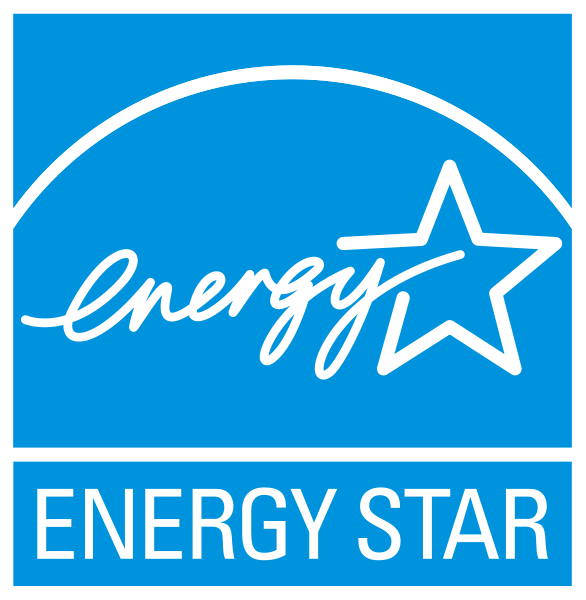ENERGY STAR® is more than a decal on your washer and dryer set or in the window of your new home. It is also a powerful business tool that can lower operating costs and even drive new business while allowing you to contribute to the preservation of the environment for future generations.
ENERGY STAR® is a joint program between the U.S. Environmental Protection Agency (EPA) and the U.S. Department of Energy (DOE). It is a voluntary program offered at no cost that helps businesses and individuals save money and protect our climate through superior energy efficiency.
In addition to energy efficient products and homes, ENERGY STAR® provides energy reduction tools and strategies for commercial buildings, including a rating based on how well they control energy consumption and utilize energy reduction best practices in their facilities. This information is derived from Portfolio Manager®, which captures cost and consumption information from commercial buildings.
Portfolio Manager® is the leading bench marking tool in the U.S. It is utilized by:
- 40 percent of U.S. commercial building space
- 35 percent of the Fortune 500®
- 50% of the largest U.S. healthcare organizations, major league sports teams, colleges and universities
- Cities such as New York, Seattle, and Boston that have passed mandatory benchmarking laws.
From the Portfolio Manager® virtual data repository ENERGY STAR® constructs a rating based on national averages of similar building types and an algorithm that produces a score between 0 and 100. Discovering your rating has many benefits however, because it is still voluntary to do so in many cities and states the ENERGY STAR Portfolio Manager® is vastly underutilized.
So Why Report if it’s Voluntary?
1. It May Be Required by Your Municipality
Depending on the municipality your buildings are located in, there may be reporting requirements required by law. In the past few years, larger cities across the U.S. have implemented these requirements to lower costs, reduce emissions and create jobs.
Even if your municipality doesn’t require reporting yet, the trend is growing every year and by earning the ENERGY STAR® now you will be in a better position to respond to any future laws or mandates.
Here are the cities and states implement bench marking and disclosure practices as of May 2014:
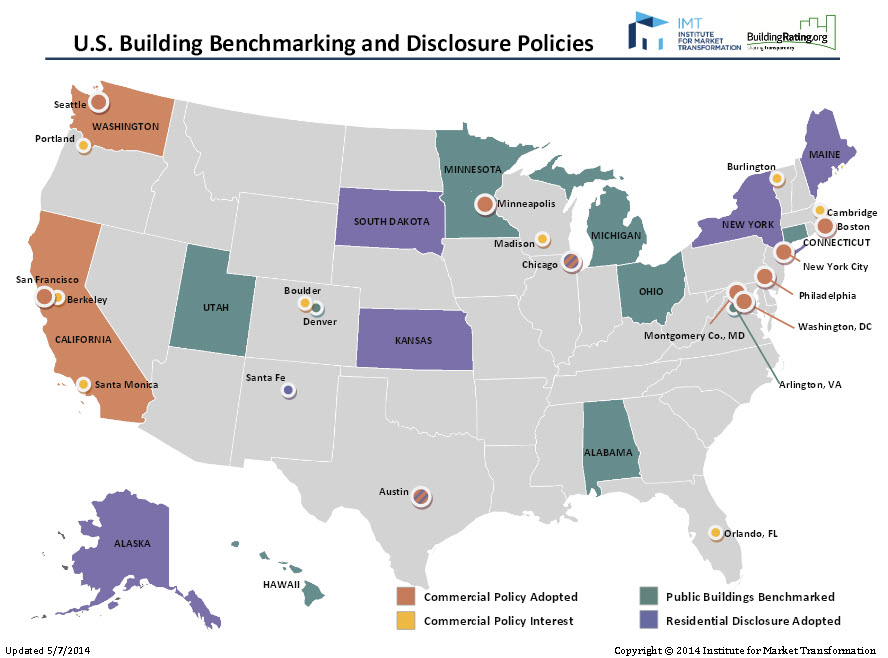
2. Cost Savings
ENERGY STAR® reporting with the portfolio manager allows you to benchmark your energy consumption and subsequent progress in mitigating it. Not only will you have a data repository for all your locations year after year, but you can also access data for buildings with similar characteristics and uses to benchmark performance.
Once you begin bench marking with ENERGY STAR® you can identify opportunities for better management and reduction of your energy costs. In addition, there are cost savings inherent in operating within ENERGY STAR® best practices. In fact data shows that, “ENERGY STAR® certified office buildings cost $0.50 less per square foot to operate than their peers. Currently, ENERGY STAR® certified buildings are saving $2.3 billion every year, or an average of nearly $140,000 per building.”
The best part is that reporting with portfolio manager is free. You need only need 12 consecutive months of whole-building data to begin bench marking process, a process commonly outsourced to cost control consultants.
3. Bragging Rights
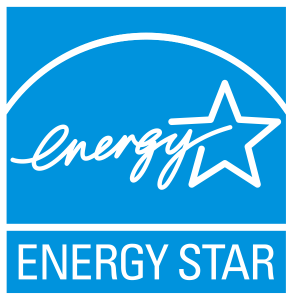 If you achieve an ENERGY STAR® rating of 75% or higher you can apply to display the ENERGY STAR® logo on your commercial property. Research findings as recent as April of this year show that as much as 87% of the American public recognizes the ENERGY STAR® brand. The same findings show that 70% of Consumers say that the ENERGY STAR® brand influences their purchasing decision.
If you achieve an ENERGY STAR® rating of 75% or higher you can apply to display the ENERGY STAR® logo on your commercial property. Research findings as recent as April of this year show that as much as 87% of the American public recognizes the ENERGY STAR® brand. The same findings show that 70% of Consumers say that the ENERGY STAR® brand influences their purchasing decision.
For larger companies this may be important for shareholders who are forward thinking and environmentally conscious and it certainly makes your business more attractive over competitors.
Additional research by CoStar has shown that buildings with an ENERGY STAR® rating of 75% or higher command higher occupancy and rent rates. As you increase your ENERGY STAR® rating across location or overwhelmingly exceed standards, your business may be in the running for awards like ENERGY STAR® Partner of the Year or an ENERGY STAR® Leader, both of which carry significant weight.
4. Financial Incentives
In addition to tax credits and deductions, which remain to be determined for 2014, there are several financial incentives for projects to make commercial buildings more energy efficient. They are available on local, state and federal levels and include:
- Directory of Energy Efficiency Programs Leveraging ENERGY STAR®: Allows you to find out which programs sponsors are offering services that will help you improve the energy performance of your commercial buildings using ENERGY STAR.
- The Department of Energy’s Database of State Incentives for Renewables & Efficiency (DSIRE): largest and most up-to-date listing of state, federal, local, and utility incentives and policies that support renewable energy and energy efficiency projects.
Additional incentives are applied to ENERGY STAR® products for the office, which include special offers and rebates. Opportunities to find financing for energy efficiency projects also exist through energy performance contracting, loans, commercial leases, tax-exempt financing, or financial advisory services. To explore this option further, see the ENERGY STAR® approved resource list.
5. Corporate Responsibility to the Environment
Businesses using ENERGY STAR® best practices are using 35% less energy and emitting 35% less greenhouse gases into the earth’s atmosphere. Aside from the overwhelming cost savings inherent in these best practices, you can easily help shape the world around you for the better.
As portrayed in the image to the right, since its inception in 1992 ENERGY STAR® has prevented, “…more than 150 million metric tons of greenhouse gas emissions annually. More than 200 billion kilowatt-hours (kWh) of electricity is saved per year, which represents 15 percent of U.S. residential electricity use. These savings have offset the need for more than 185 additional power plants.” – page 3, “ENERGY STAR Products: 20 Years of Helping America Save Energy, Save Money and Protect the Environment.”
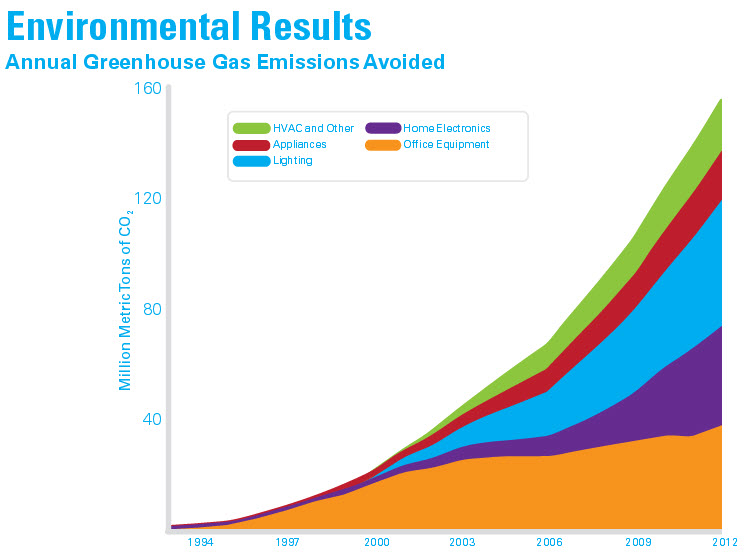
As you can see in the graph, excessive energy consumption and emissions are decreasing at an exponential rate, and you can help contribute to this strengthening trend.
What’s Coming?
The trend is clearly toward corporate responsibility towards the environment. Consumers and investors look for it and now cities and states are beginning to require reporting. It is likely there will be penalties and fines instituted if you don’t meet standards in these locations. For a glimpse into the future, just look at Europe which has had energy conservation and reporting laws in place since the early 2000’s.
It’s best to begin bench marking now even if not yet required by your city or state. Even if you receive a poor rating you will be able to benchmark and identify where to improve energy usage practices and mitigate costs, and thus your Energy Star rating.
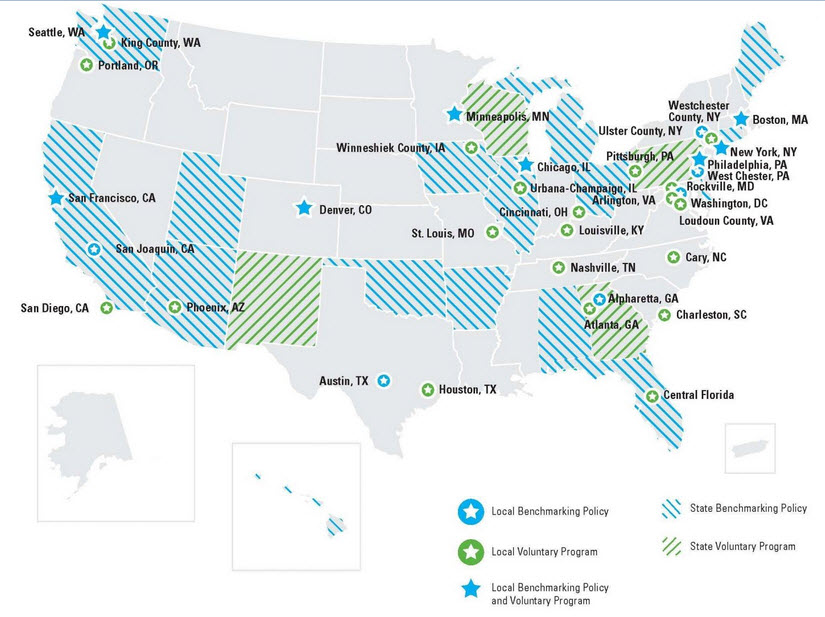
We help clients use the ENERGY STAR Portfolio Manager. Maybe we can help you.

